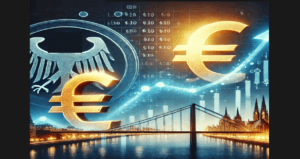Euro Surges to 4-Month High as German Spending Boosts Confidence, Dollar Slumps
The euro surged to a four-month high against the U.S. dollar, driven by rising European bond yields following Germany’s announcement of a €500 billion ($539.85 billion) infrastructure fund and revised borrowing limits. The U.S. dollar remained weak after the Trump administration delayed auto tariffs for Canada and Mexico, boosting investor confidence. Risk-sensitive currencies like the British pound and the Australian dollar also gained, with sterling reaching a four-month peak. While China’s pledge for more stimulus supported the Aussie, the yuan slightly retreated.
Germany’s 30-year bond yields spiked up to 25 basis points in response to expected borrowing. The euro climbed 0.3% to $1.0820 and is up 4.3% this week, marking its best performance since 2009. Investors are now awaiting the European Central Bank’s decision, with a widely expected rate cut in focus. Sterling hit $1.2913, its highest since November 11, while analysts pointed to a decline in U.S. exceptionalism in interest rate markets. Meanwhile, Wall Street saw gains as markets reacted to shifting global trade and economic policies.

Euro Surges to 4-Month High as German Spending Boosts Confidence, Dollar Slumps
The euro continued its rally against the U.S. dollar on Thursday, reaching a four-month high following a sharp rise in European bond yields. This surge was driven by Germany’s announcement of a €500 billion ($539.85 billion) infrastructure fund and revisions to its borrowing limits.
Meanwhile, the U.S. dollar remained near a four-month low against major currencies after the Trump administration granted Canada and Mexico a one-month reprieve from auto import tariffs. This policy shift contributed to market optimism, benefiting risk-sensitive currencies such as the British pound and the Australian dollar. Sterling climbed to a four-month peak, while the Australian dollar also gained, supported by strong domestic economic data and China’s commitment to further stimulus measures. The Chinese yuan, however, retreated slightly after reaching a four-month high.
Kyle Rodda, a senior financial markets analyst at Capital.com, noted the significance of Germany’s fiscal moves, highlighting the government’s willingness to leverage its financial resources. He also pointed out that while U.S. trade policy remains a key source of uncertainty, the temporary tariff relief reassured investors that tensions may not escalate further.
Germany’s bond yields spiked in response to the anticipated increase in borrowing, with 30-year yields rising by as much as 25 basis points at one point.
By Thursday, the euro had gained 0.3%, reaching $1.0820 for the first time since November 7. The currency has risen 4.3% this week, marking its strongest performance since March 2009. Investors are now looking ahead to the European Central Bank’s upcoming policy decision, where a widely expected quarter-point rate cut will be closely examined for indications of future easing measures.
The British pound also saw gains, reaching $1.2913—its highest level since November 11. Analysts at DBS noted that the recent shifts in interest rate dynamics have reduced the U.S. dollar’s relative strength in global markets.
The euro continued its upward momentum against the U.S. dollar, fueled by Germany’s proposed €500 billion ($539.85 billion) infrastructure fund and changes in borrowing limits. The dollar remained near a four-month low as the Trump administration granted a one-month reprieve on auto import tariffs for Canada and Mexico, highlighting ongoing trade uncertainties.
The British pound and Australian dollar also strengthened, while the offshore yuan fluctuated near recent highs. Germany’s 30-year bond yields surged up to 25 basis points as investors factored in increased borrowing. The euro reached $1.0803, its highest level since November 8, and is up nearly 4% this week, on track for its best performance since March 2020. Investors await the European Central Bank’s policy decision, with a rate cut expected and focus on future easing measures. Sterling climbed to $1.2906, and the U.S. dollar index remained around 104.31.
The dollar strengthened against the yen but saw slight declines against the Canadian dollar and Mexican peso. Meanwhile, Beijing’s annual parliamentary meeting emphasized boosting consumption to support economic growth amid U.S. trade tensions.
Check out TimesWordle.com for all the latest news
You must be logged in to post a comment.